百内国家公园, 巴塔哥尼亚, 智利 Torres del Paine National Park, Patagonia, Chile (© Marco Bottigelli/Getty Images)
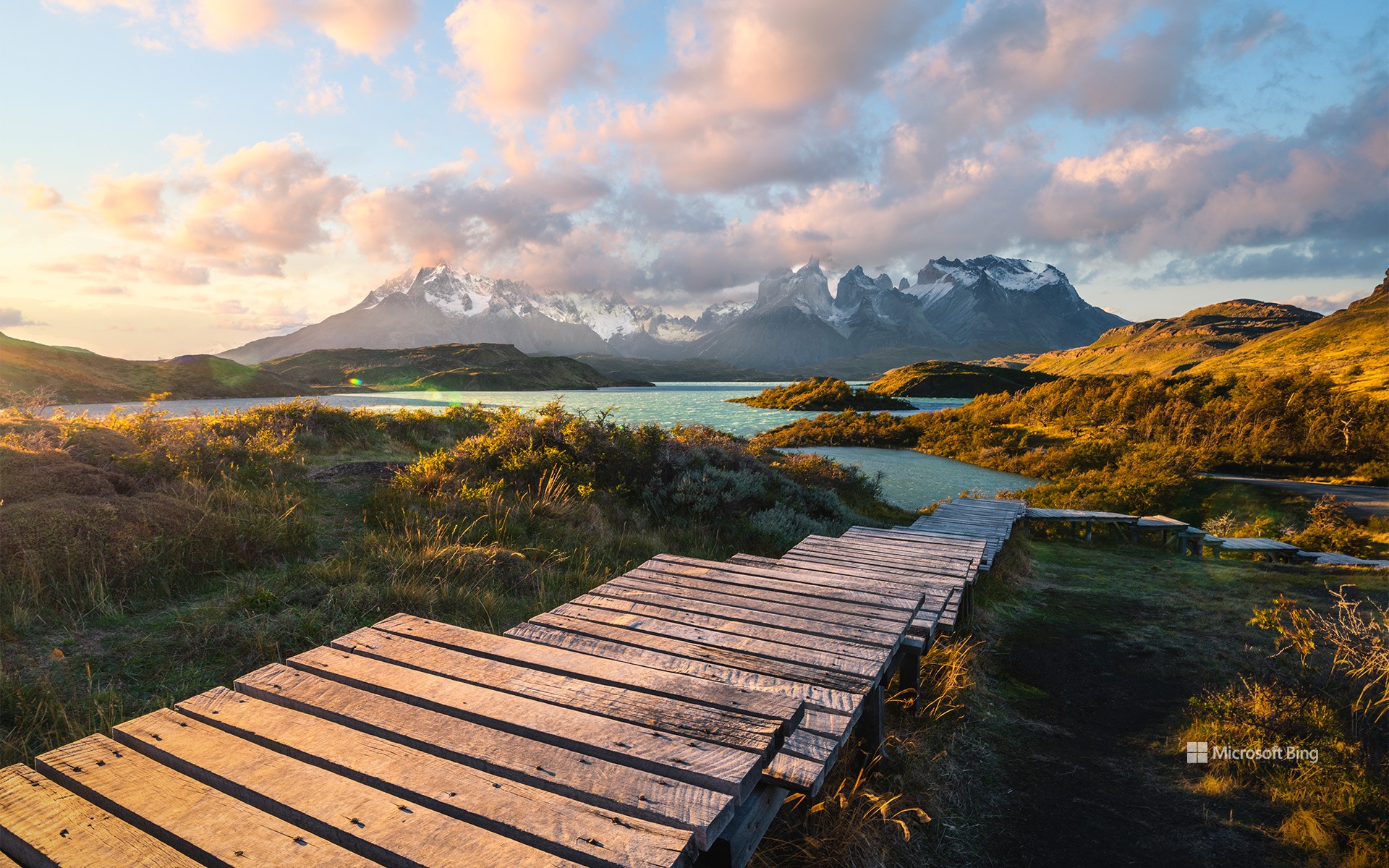
百内国家公园, 巴塔哥尼亚, 智利 Torres del Paine National Park, Patagonia, Chile (© Marco Bottigelli/Getty Images)
66岁,依然美丽动人 66 and still gorgeous
百内国家公园, 巴塔哥尼亚, 智利
在智利最壮丽的自然保护区之一,野生动物自由穿梭,高耸的山峰与古老的冰川共同塑造出这片原始而壮观的土地。百内国家公园于 1959 年的今天正式成立,至今已满 66 岁,面积超过 448,000 英亩。最初它被称为格雷湖国家旅游公园,1970 年更名为百内国家公园,1978 年被联合国教科文组织指定为生物圈保护区。公园中最具标志性的地貌是三座高达 8,000 英尺以上的巨大花岗岩尖峰:百内塔。这些岩柱由岩浆侵入、地壳抬升,以及数百万年的冰川侵蚀共同形成,最终留下了今天令人惊叹的锯齿状山峰。
公园的湖泊和河流由融化的冰川补给,形成了一个水系网络,滋养着这里的野生动物。南巴塔哥尼亚冰原为四条主要冰川:廷德尔、格雷、迪克森和萨帕塔冰川提供补给。百内河发源于迪克森湖,流经多个水体,包括百内湖、诺登舍尔德湖和佩欧埃湖等。这里野生动物繁多,有美洲狮、濒危的南安第斯鹿、智利火烈鸟以及智利红头美洲鹫。公园内草原、湿地和森林交织,为多样的植物群落提供了栖息地,其中包括南极山毛榉、冷杉山毛榉和耐寒的垫状植物,它们顽强地适应了这片严酷的自然环境。
Torres del Paine National Park in Patagonia, Chile
Wildlife roams freely in one of Chile's most stunning protected areas, where towering peaks and ancient glaciers shape the land. Torres del Paine National Park in Patagonia was established on this day in 1959. Originally called Grey Lake National Tourism Park, it was renamed in 1970 and designated a UNESCO Biosphere Reserve in 1978. Its most recognizable features—three massive granite peaks known as the Torres—stand over 8,000 feet tall. These formations took shape through magma intrusion and uplift, followed by millions of years of glacial erosion, leaving behind the jagged spires seen today.
The park's lakes and rivers, fueled by melting ice, create a hydrological network that sustains its wildlife. Four major glaciers—Tyndall, Grey, Dickson, and Zapata—are fed by the Southern Patagonian Ice Field. Originating from Dickson Lake, the Paine River flows through various bodies of water, including Paine Lake, Nordenskjöld Lake, and Pehoé Lake. Wildlife thrives here, including pumas, endangered southern huemuls (south Andean deer), Chilean flamingos, and chimango caracaras. With grasslands, wetlands, and forests, the park supports a range of plant life, including lenga and Antarctic beech, and cushion plants that endure the harsh climate.
两只原驼, 托雷斯德尔帕恩国家公园 , 智利 Guanacos, Torres del Paine National Park, Chile (© Floris van Breugel/NPL/Minden Pictures)
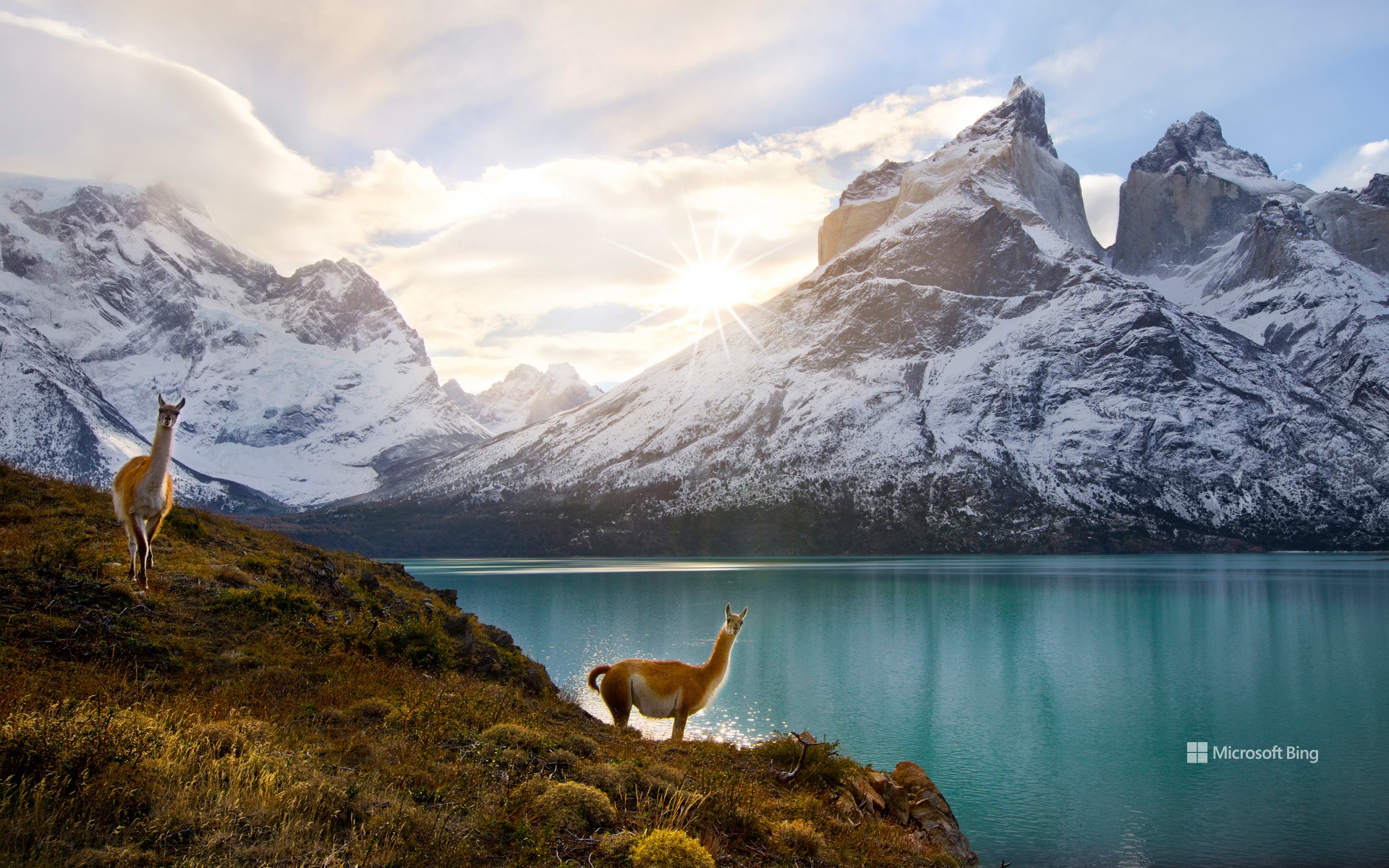
两只原驼, 托雷斯德尔帕恩国家公园 , 智利 Guanacos, Torres del Paine National Park, Chile (© Floris van Breugel/NPL/Minden Pictures)
态度和高度 Attitude and altitude
原驼, 托雷斯德尔帕恩国家公园 , 智利
原驼是南美洲的本土动物,主要分布在美洲大陆中西部一带,大多栖息在秘鲁与玻利维亚交界的安第斯山脉。原驼生性机警敏捷,喜欢成群外出觅食,性格相对温顺。
原驼是一种体型优雅修长的动物,肩高1.0至1.3米,体长2.1至2.2米,体重90至140公斤。它们的体色变化很小,背上没有驼峰,大多数身上披满红褐色的毛,内层的绒毛为白色。与原驼同属的其他朋友还有:骆驼、骆驼、羊驼等。
Llama Day
Prick up your ears and crane your neck—it's National Llama Day. Part of a family that includes camels, alpacas, and guanacos, llamas have long been domesticated in South America because of their hardiness and ability to thrive on the bleak vegetation in the mountains and plateaus of the Andes. At up to 6 feet tall and weighing up to 400 pounds, they were used primarily as pack animals for about 6,500 years. They were also bred as a source of food, hides, tallow for candles, dung for fuel, and fabric. While inferior to alpaca and guanaco wool, llama fleece is soft, warm, durable, and fairly lightweight. It's used for clothing, rugs, and rope.
Unlike their wild guanaco cousins, seen in today's image in Torres del Paine National Park, Chile, llamas have been popular on farms across the US since the 1980s. Llamas are surprisingly clean, smart, and loyal companions that can even be trained as therapy animals. Their gentle nature has made them popular at petting zoos and farms, and unlike their camel cousins, they rarely spit at humans. They're also good guard animals that will charge at predators and scream at intruders. With a population of almost 30,000 in the country, Americans have clearly fallen in love with llamas.
阿胡汤加里基的日出,拉帕·努伊国家公园,复活节岛,智利 Sunrise at Ahu Tongariki, Rapa Nui National Park, Easter Island, Chile (© Piriya Photography/Getty Images)
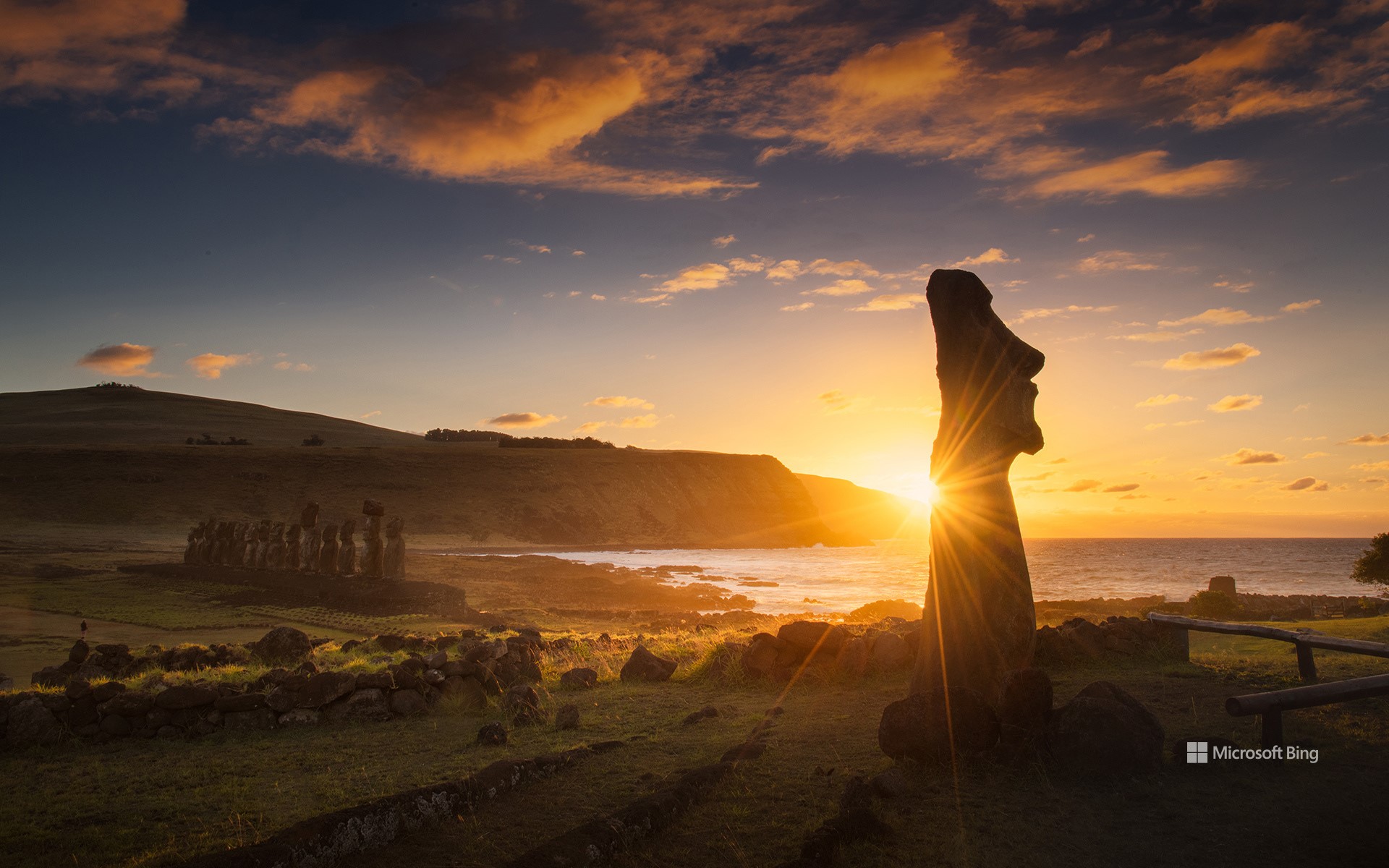
阿胡汤加里基的日出,拉帕·努伊国家公园,复活节岛,智利 Sunrise at Ahu Tongariki, Rapa Nui National Park, Easter Island, Chile (© Piriya Photography/Getty Images)
古老又神秘 Ancient and mysterious
拉帕·努伊国家公园,复活节岛,智利
欢迎来到拉帕努伊岛,该岛也被称为智利的复活节岛,是世界上最偏远、最迷人的天堂之一。这座令人惊叹的岛屿以其标志性的摩艾石像而闻名,是一座拥有壮丽景观和丰富文化遗产的宝库。专家们对波利尼西亚人到来的时间众说纷纭,但许多研究人员认为应该是在8世纪左右。作为世界遗产的复活节岛占地超过17,000英亩,包括附近的四个小岛。在岛上,你可以欣赏到今天的图片所展示的迷人日出,探索矗立着宏伟雕像的火山口和郁郁葱葱的草地。
对这座岛屿的名字感到好奇吗?原住民称它为拉帕努伊,意思是“大拉帕”,指的是这片土地的地形与澳大利亚群岛的拉帕岛相似。荷兰探险家雅可布·罗赫芬是第一个访问该岛的欧洲人,他将该岛命名为帕斯奇-艾兰,即英语中的“复活节岛”,以纪念他在复活节当天抵达该岛。虽然复活节似乎离今天很遥远,但你全年都可以探索这个独特的世界遗产。深入了解其充满活力的历史,让这座岛屿用魅力征服你。
Rapa Nui National Park, Easter Island, Chile
Welcome to Rapa Nui, also known as Easter Island, one of the world's most remote and enchanting paradises, roughly 2,330 miles west of mainland Chile. Famous for its iconic moai statues, Rapa Nui boasts breathtaking landscapes and rich cultural heritage. Experts are divided on when the island's ancestral inhabitants first arrived from Polynesia, though many researchers suggest it was around the 8th century. Take in the mesmerizing sunrise featured in today's image and explore the striking volcanic craters and lush, grassy plains where the imposing statues stand. The World Heritage property of Easter Island spans more than 17,000 acres, including four nearby islets.
The island's original inhabitants call it Rapa Nui, meaning 'Great Rapa,' referring to the land's similarity to Rapa Island, in French Polynesia. Dutch explorer Jacob Roggeveen, the first European to visit, named it Paasch-Eyland, or 'Easter Island' in English, to mark his arrival on Easter Sunday. You can explore this unique World Heritage site year-round. Dive into its vibrant history and let the island's charm sweep you away.
马可罗尼企鹅,德雷克海峡,智利 Macaroni penguins, Drake Passage, Chile (© Paul Souders/Getty Images)
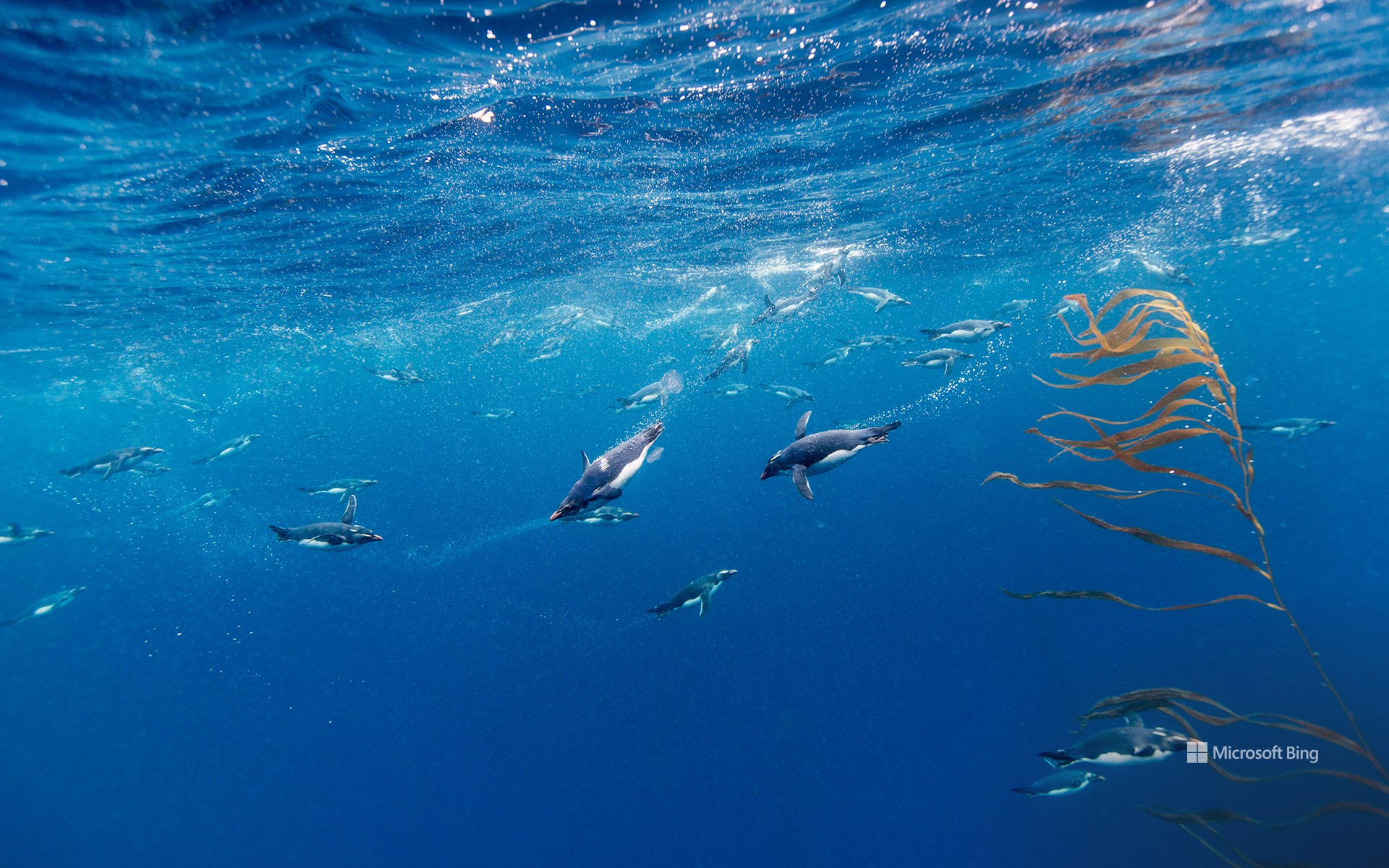
马可罗尼企鹅,德雷克海峡,智利 Macaroni penguins, Drake Passage, Chile (© Paul Souders/Getty Images)
冰雪极地的马可罗尼企鹅 Macaroni and freeze
企鹅意识日
让我们行动起来,一起投入到企鹅意识日的活动中去吧!你能说出多少种企鹅的名字?今天的照片展示的是敏捷的马可罗尼企鹅在智利德雷克海峡浮游生物丰富的水域中畅游的场景。这些迷人的生物只是在南半球发现的18种企鹅中的一种,可以通过它们奇特的橘色装饰性羽毛和突出的橙色喙来识别。马可罗尼企鹅成群结队地觅食,但雄性企鹅之间会相互攻击。为了表现出和气和避免打斗,个体通常会把头缩在胸前,这样就可以轻松地穿过企鹅群。尽管企鹅深受人类的喜爱,但近年来食物的减少、渔网的误捕,以及气候变化对其栖息地海冰的深刻影响,都对企鹅的生存构成不小威胁。
Penguin Awareness Day
Let's flap our flippers and dive into Penguin Awareness Day! Today's image features macaroni penguins swimming in the plankton-rich waters of the Drake Passage off the coast of Chile. These charming creatures, one of 18 different species of penguin in the Southern Hemisphere, can be recognized by their flashy amber crests and orange beaks. The name is said to have been coined by English sailors, derived from a term used to describe flamboyant dressers in the late 18th century.
Macaroni penguins can be a bad-tempered bunch who get into noisy fights. To avoid this, males often ease their way through crowded colonies with their heads tucked down to their chests. The main threats though, are not their fellow penguins. Reduced food availability, fishing nets, and the impact of climate change on sea ice are among challenges faced by this species, which has been classified as vulnerable due to population decline.
佩霍湖,百内国家公园,智利南部 Lake Pehoé, Torres del Paine National Park, Chile (© OST/Getty Images)
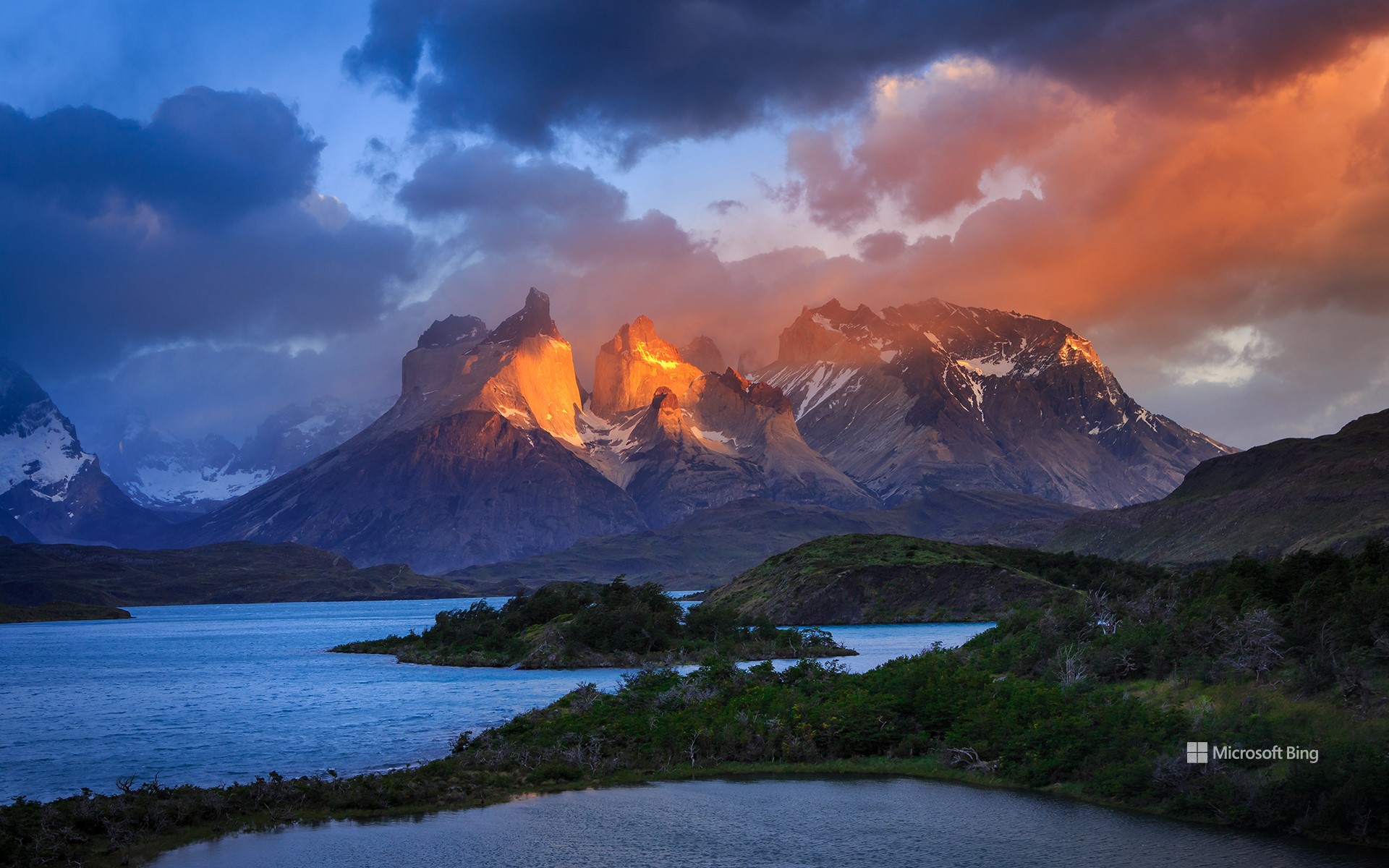
佩霍湖,百内国家公园,智利南部 Lake Pehoé, Torres del Paine National Park, Chile (© OST/Getty Images)
照亮你忧郁的心 Shine a light into your blues
佩霍湖,百内国家公园,智利南部
蓝绿色的湖面上倒映着蔚蓝的天空,周围是嶙峋的山峰和郁郁葱葱的森林,这就是佩霍湖。这个冰川湖坐落在智利南部的百内国家公园内,是大自然的杰作。佩霍湖周围那高耸入云的百内犄角山(因形状酷似牛角而得名)和百内山丘也是一道特别的风景线。佩霍湖的湖水呈现出独特的绿松石蓝,是因为水中悬浮着被称为冰川粉或岩粉的细小岩石颗粒和矿物质。据说“Paine”(百内)一词源于特维尔切语,意为“蓝色”。1978年,百内国家公园被联合国教科文组织认定为生物圈保护区,其面积达700平方英里。徒步、划船、观星……公园里有许多精彩的游玩项目,带上你的冒险精神,向南出发,来一段“告别忧郁”之旅吧!
Lake Pehoé, Torres del Paine National Park, Chile
Turquoise waters surrounded by jagged peaks and lush forests—that's Lake Pehoé for you. Nestled in Torres del Paine National Park, Chile, this glacial lake reflects the towering peaks of the Cuernos del Paine, pictured here bathed in the sun's rays. The lake gets its color from finely ground rock particles and minerals, known as glacial flour, suspended in the water. The word 'paine,' pronounced pie-neh, in the park’s name is believed to have its roots in a Tehuelche word meaning 'blue' while 'torres' means towers. The park is named after three striking granite peaks that reach up to 8,200 feet above sea level but boasts many other spectacular mountains. At 700 square miles, Torres del Paine is a UNESCO Biosphere Reserve with a huge amount to offer visitors, from hiking and kayaking to stargazing. So, pack your sense of adventure and head south to beat the blues.
阿卡切斯瞭望台,月亮谷,智利 Achaches lookout, Valley of the Moon, Chile (© Ignacio Palacios/Getty Images)
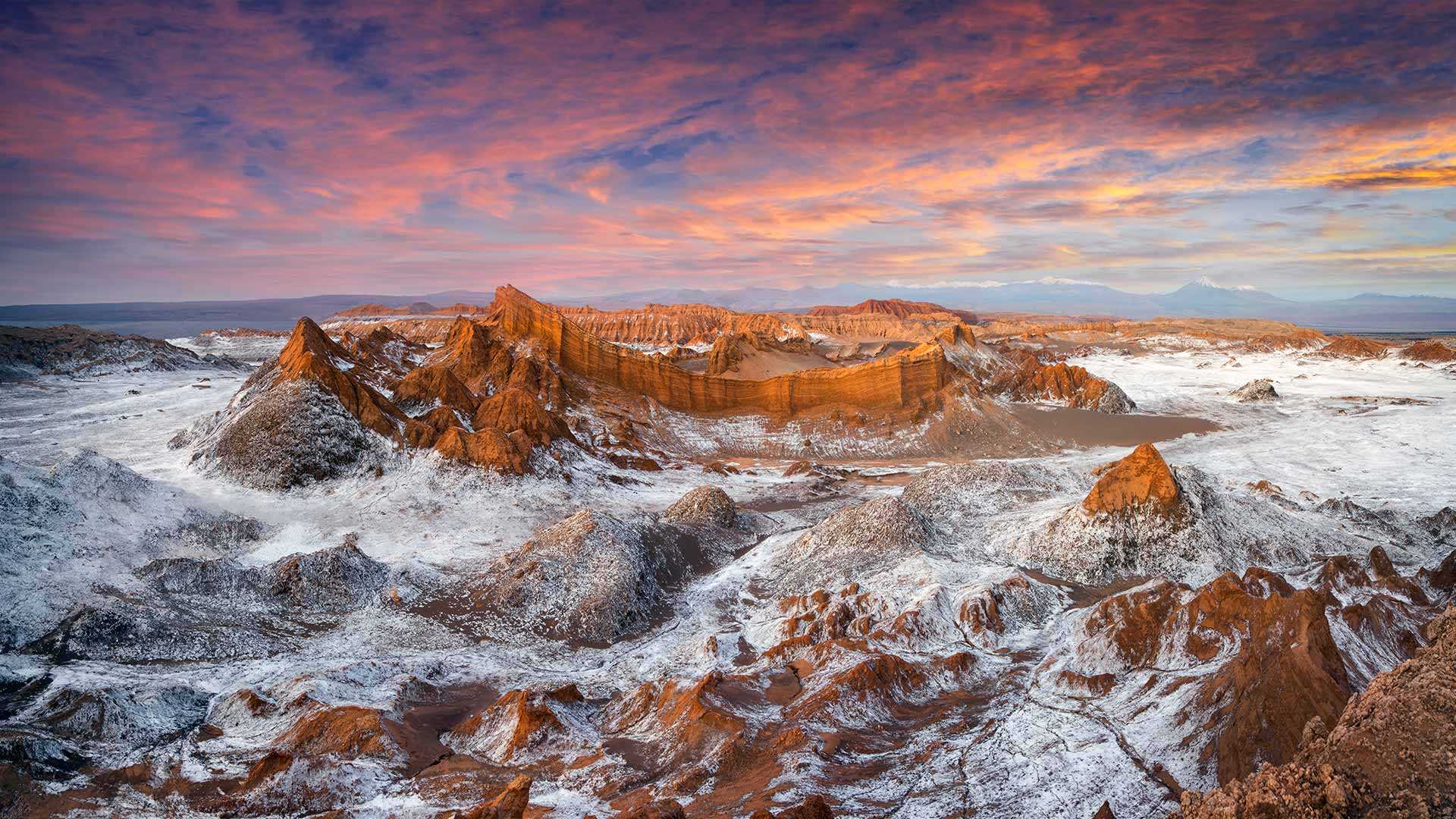
阿卡切斯瞭望台,月亮谷,智利 Achaches lookout, Valley of the Moon, Chile (© Ignacio Palacios/Getty Images)
带我飞向月球 Fly me to the moon
月亮谷,智利
月亮谷位于智利北部的阿塔卡马沙漠,有着令人惊叹的美景。1982年,月亮谷被列为自然保护区,这是因为它拥有极吸引人的、未受破坏的原生环境和奇特的月球地形。关于月亮谷还有一个有趣的知识,那就是这片沙漠已经很多年未下过一滴雨了。
Achaches lookout, Valley of the Moon, Chile
El Valle de la Luna (Valley of the Moon) is located in the Atacama Desert of northern Chile. It has the most breathtaking view from the Achaches lookout. In 1982, Moon valley was declared a nature sanctuary for its stunning, untouched habitat and its peculiar lunar-like terrain. An interesting fact about the Valley of the Moon is that the desert hasn't received a single drop of rain in countless years.
复活节岛上的摩艾石像,智利 Moai statues on Easter Island, Chile (© Karine Aigner/Tandem Stills + Motion)
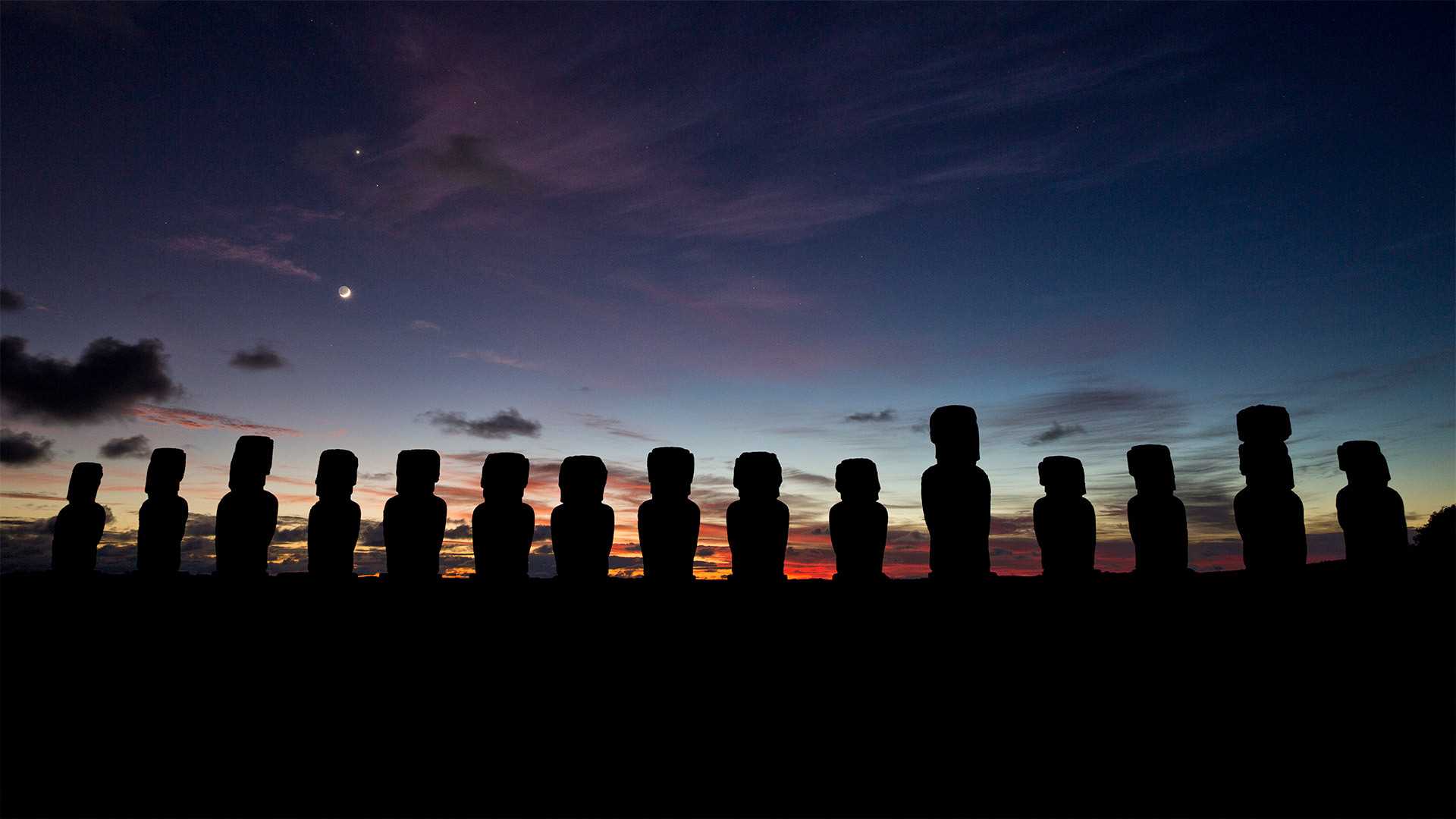
复活节岛上的摩艾石像,智利 Moai statues on Easter Island, Chile (© Karine Aigner/Tandem Stills + Motion)
摩艾石像 Big rocks, big heads
摩艾石像,智利
今天,照片上呈现的是久负盛名的摩艾石像,它位于智利偏远的复活节岛上。这些巨人石像是由拉帕努伊人在1250年到1500年之间用岩石雕刻而成的,全岛共有近1000座石像。考古学家认为,拉帕努伊人用这些石像纪念他们的祖先,并将其视为权力和权威的象征。这些石像里有7座面朝大海,其余石像都是背对着太平洋,面朝内陆看着村庄,仿佛是在保护着拉帕努伊人。
Moai statues on Easter Island, Chile
Today we're looking at something you may have heard about before—the famous Moai statues on Chile's remote Easter Island. These big-headed statues were carved out of solidified volcanic ash by the Rapa Nui people between 1250 and 1500, and there are nearly 1,000 of them on the island. Archaeologists believe they were meant to honor Rapa Nui ancestors and were revered as symbols of power and authority. All but seven of the statues face away from the surrounding Pacific Ocean, and instead look inward toward the villages, as if positioned to watch protectively over the Rapa Nui.
拉西拉ESO天文台上的天文望远镜设备,智利 Swedish antenna at La Silla ESO Observatory, Chile (© Alberto Ghizzi Panizza/Getty Images)
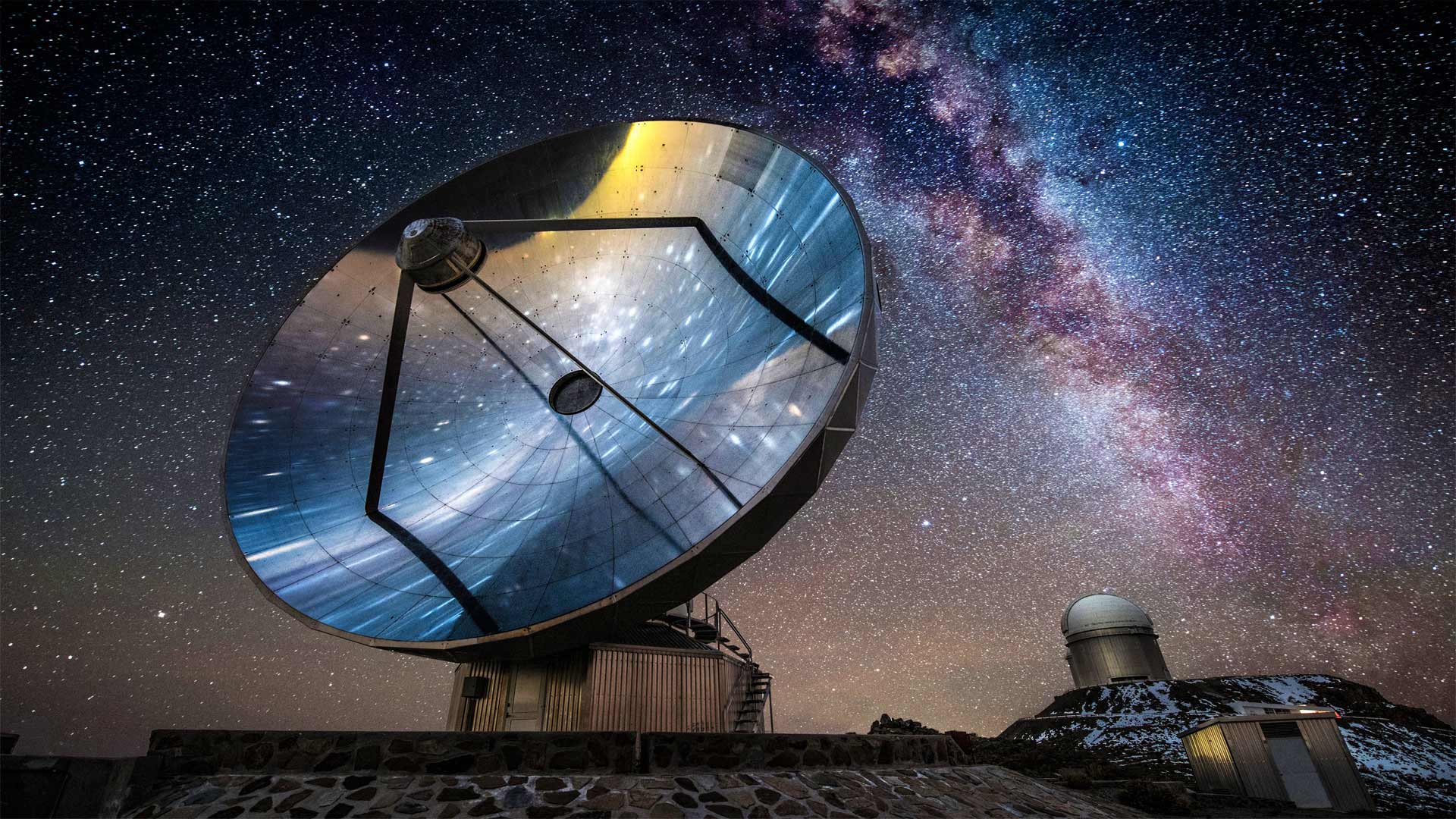
拉西拉ESO天文台上的天文望远镜设备,智利 Swedish antenna at La Silla ESO Observatory, Chile (© Alberto Ghizzi Panizza/Getty Images)
仰望夜空 Eyes on the skies
Astronomy Day
In one of the darkest places on Earth there's a cluster of telescopes that examine the heavens each night, sending detailed information about the celestial bodies they observe to astronomers across the planet. Far from any population centers or light pollution, the Atacama Desert is the world's driest nonpolar desert. It's the perfect place for La Silla Observatory, one of the largest observatories in the Southern Hemisphere, and the first to be used by the European Southern Observatory (ESO), a research organization made up of astronomers from 16 European nations. The first ESO telescope at the La Silla site in Chile began operating in 1966.
And what better place to spend World Astronomy Day? Started in 1973 by Doug Berger, the president of the Astronomical Association of Northern California, Berger's initial intent was to set up various telescopes in busy urban locations so that passersby could enjoy views of the heavens. Since then, the event has expanded and is now sponsored by several organizations associated with astronomy. The springtime Astronomy Day is mirrored by another in the fall between mid-September and mid-October.
天文日
在地球上最黑暗的地方之一,每天晚上都有一组望远镜检查天空,向地球各地的天文学家发送有关他们观察到的天体的详细信息。阿塔卡马沙漠远离任何人口中心或光污染,是世界上最干燥的非极性沙漠。这是南半球最大的天文台之一拉西拉天文台的完美地点,也是欧洲南方天文台(ESO)首次使用的天文台,该研究机构由来自16个欧洲国家的天文学家组成。智利拉希拉基地的第一台ESO望远镜于1966年开始运行。
还有什么地方能更好地度过世界天文日呢?1973年,北加州天文协会主席道格·伯杰(Doug Berger)创立了该望远镜,伯杰最初的意图是在繁忙的城市地点安装各种望远镜,以便路人可以欣赏天空。从那时起,这项活动已经扩大,现在由几个与天文学有关的组织赞助。9月中旬至10月中旬之间的秋季,春季天文学日与另一个天文学日相映成趣。
帕瑞纳天文台的望远镜和星迹,智利阿塔卡马沙漠 Telescopes and star trails at Paranal Observatory, Atacama Desert, Chile (© Matteo Omied/Alamy)
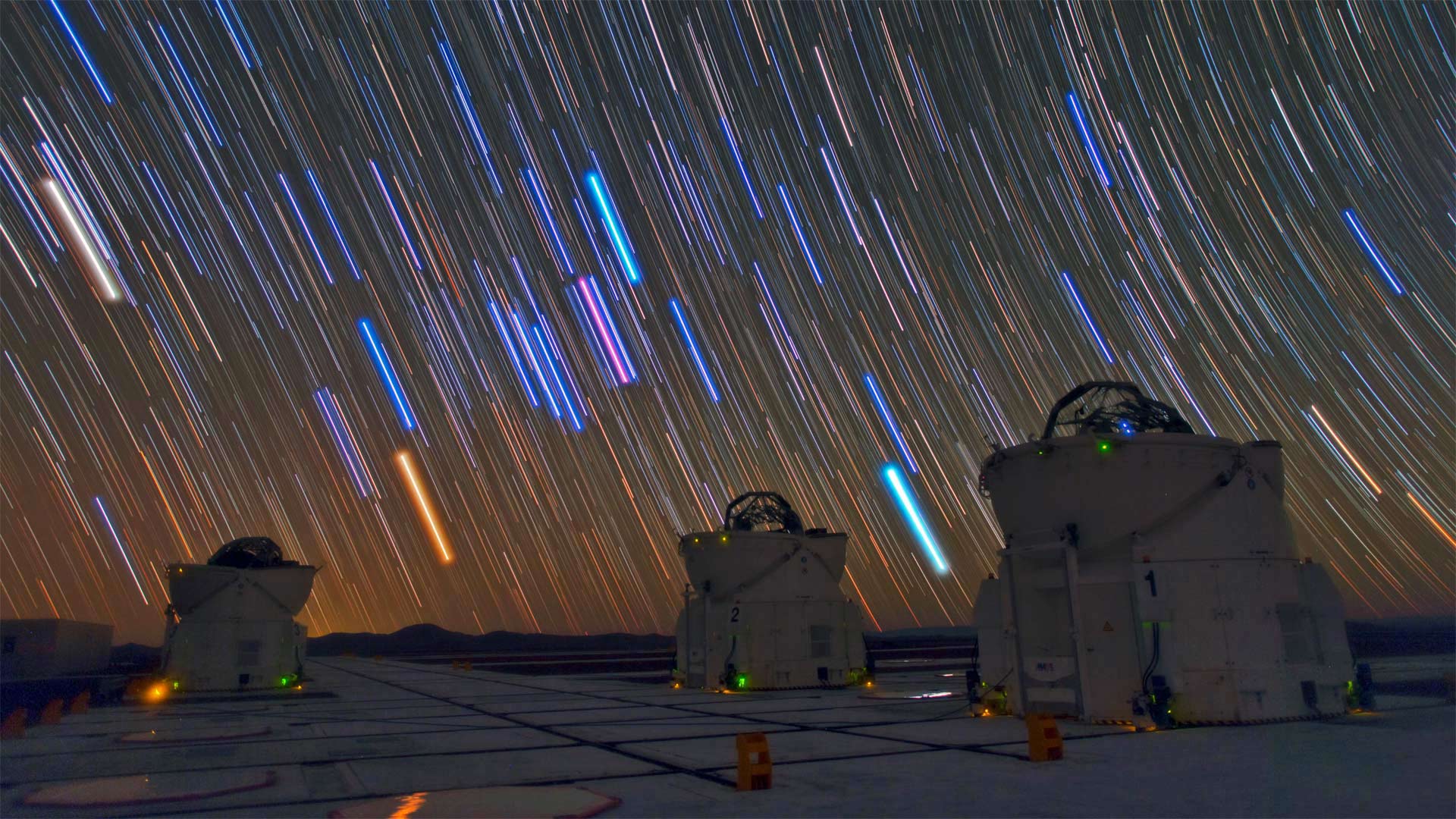
帕瑞纳天文台的望远镜和星迹,智利阿塔卡马沙漠 Telescopes and star trails at Paranal Observatory, Atacama Desert, Chile (© Matteo Omied/Alamy)
Happy Astronomy Day!
No, that's not a downpour of lightsabers—but it's no typical night sky either. Stargazing here at Paranal Observatory, on a mountaintop in Chile's desolate Atacama Desert, you'll get one of the clearest possible naked-eye views of the southern skies. This 'lightsaber' effect comes from the photo's long exposure: What we're seeing is these stars' paths as they track across the night sky due to our planet's rotation. The dazzling colors indicate temperature, from chilly red (5,000-ish degrees Fahrenheit) to balmy blue (temps in the tens of thousands).
What about those structures beneath the starry sky? They're three of the eight telescopes making up the Very Large Telescope, an aptly named project of the European Southern Observatory. Together the telescopes compose photographs of astronomically fine focus: If you were to drive a car on the surface of the moon (which we don't advise trying), the VLT could snap a crystal-clear shot of your headlights.
天文学节快乐!
不,那不是一场光剑雨,但也不是典型的夜空。在智利荒凉的阿塔卡马沙漠的山顶上,你可以用肉眼看到最清晰的南方天空。这种“光剑”效应来自于照片的长时间曝光:我们看到的是由于我们星球的自转,这些恒星在夜空中的轨迹。耀眼的颜色表示温度,从冷红色(5000华氏度)到温和的蓝色(数万华氏度)。
星空下的那些建筑呢?它们是组成超大型望远镜的八个望远镜中的三个,这是欧洲南方天文台的一个恰当命名的项目。这些望远镜一起组成了天文上精细聚焦的照片:如果你在月球表面驾驶一辆汽车(我们不建议你尝试),VLT可以拍下你的头灯的清晰照片。
亚伊马火山与前景中的智利南洋杉,智利孔吉利奥国家公园 Volcano Llaima with Araucaria trees in the foreground, Conguillío National Park, Chile (© Fotografías Jorge León Cabello/Getty Images)
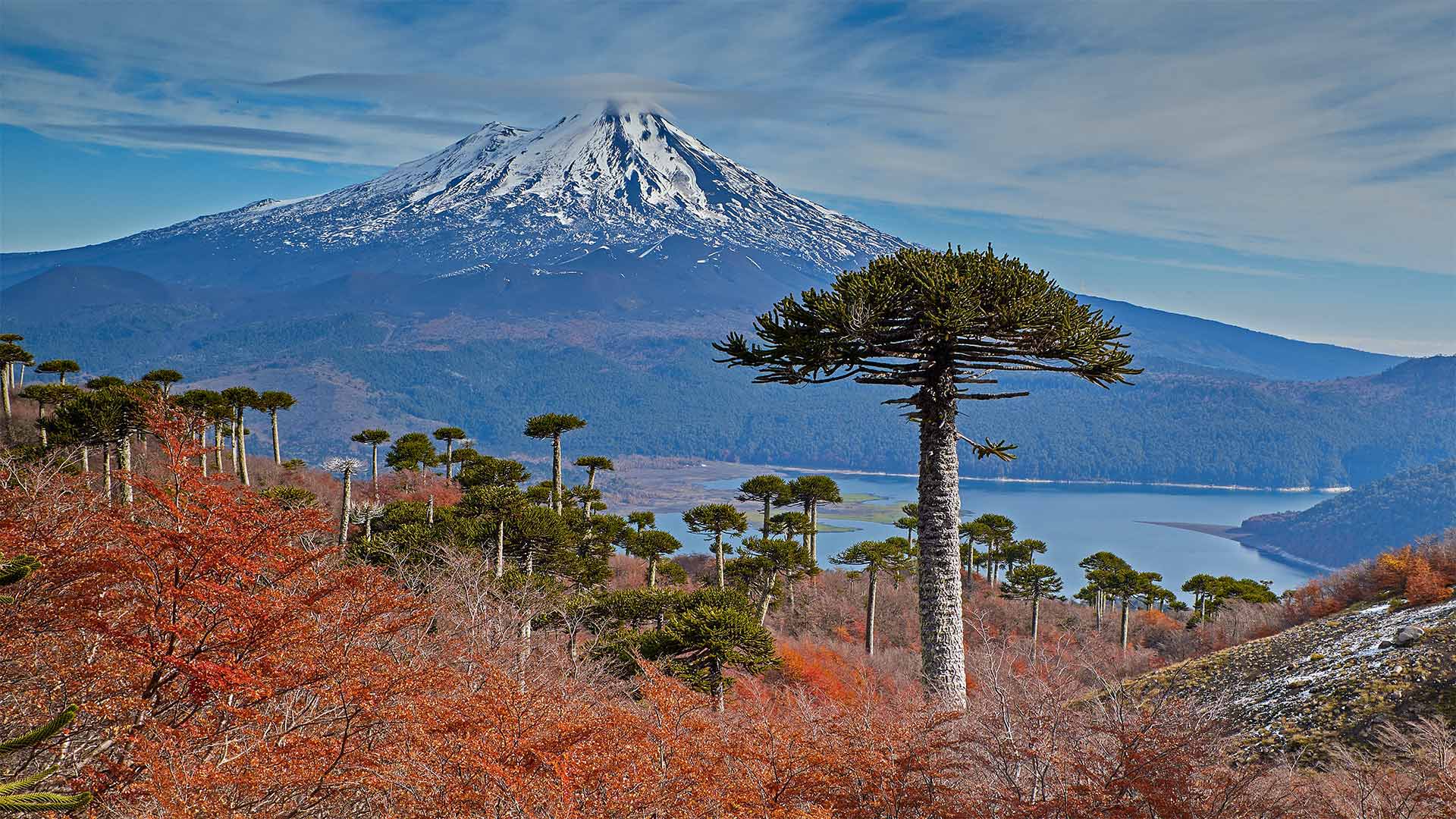
亚伊马火山与前景中的智利南洋杉,智利孔吉利奥国家公园 Volcano Llaima with Araucaria trees in the foreground, Conguillío National Park, Chile (© Fotografías Jorge León Cabello/Getty Images)
Fall for Chile
Autumn in Chile varies widely as one travels from the Atacama Desert in the north more than 2,600 miles south to the tip of Tierra del Fuego. Around halfway between these two extremes you can find Conguillío National Park and the volcano Llaima at Chile's center. In March, at the start of the Southern Hemisphere's autumn, the leaves of the deciduous forest begin to turn color and fall, and the native Chilean pine trees (Araucarias) stand out even more strikingly.
Because of their distinctive appearance and the fact that they thrive in a wide range of climates, the trees became a favorite of botanists in the 19th century, who transported and cultivated them in many temperate climates around the world. The 'monkey puzzle' trees got their common English name in the 1850s when English barrister Charles Austin observed that 'It would be a puzzle for a monkey to climb that.' Even more amazing is that these trees can live over a thousand years and are themselves living fossils, descended from a lineage stretching back 260 million years to the time of the dinosaurs.
爱上智利
智利的秋天变化很大,人们从北部的阿塔卡马沙漠向南行驶2600多英里,到达火地岛的顶端。在这两个极端的中间,你可以看到智利国家公园和智利中心的拉伊马火山。今年3月,南半球秋季伊始,落叶林的树叶开始变色、飘落,智利本土的松树(Araucarias)更加引人注目。
由于其独特的外观和在各种气候条件下茁壮成长的事实,这些树在19世纪成为植物学家的最爱,他们在世界各地的许多温带气候条件下运输和栽培它们。19世纪50年代,英国大律师查尔斯·奥斯汀(Charles Austin)指出,猴子爬上那棵树将是一个谜,于是“猴子拼图”树就有了共同的英文名称。更令人惊奇的是,这些树能活上一千多年,而且本身就是活化石,其世系可追溯到公元前2.6亿年恐龙。